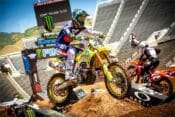BMW G 310 GS vs. KTM 390 Adventure vs. Royal Enfield Himalayan
We hit the pavement and dirt roads on three small-bore and very affordable ADV motorcycles. All three prove that you don’t need big horsepower to have big ADV fun, but which one is most fun?
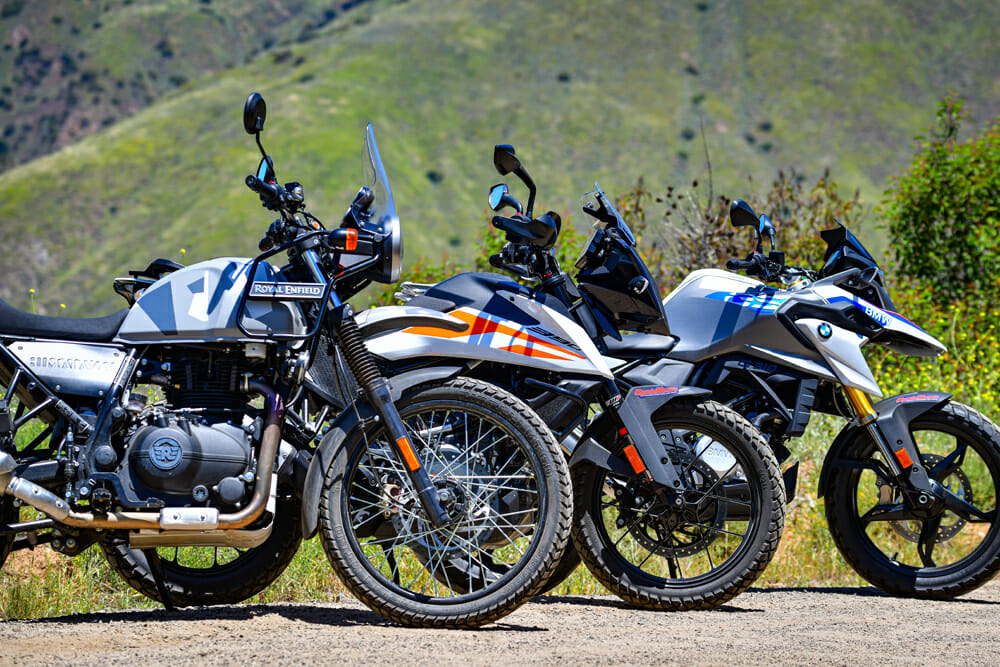
Photography by Kit Palmer
To be completely honest, top-level adventure motorcycles are getting a little bit out of control. It’s cool to have 150 horsepower firing out of multiple cylinders and dynamic motorcycle motion-control systems communicating to tires and engines and suspension bits every millisecond and all, but holy crap, if that’s the only direction to go when hitting the ADV scene, especially for first-timers, we’re doomed.
There must be an adventure-motorcycle gateway. A taste of adventure-motorcycle freedom without intimidation. A modern take on simpler motorcycles of the past that spearheaded all-terrain global intrepidness, perhaps? Something that doesn’t annihilate the wallet so you can afford to skip work to ride it would be nice, too. Road-worthy choices deserve a starting point.

For many new riders or those looking for a simple choice to do all that motorcycling can do, the KTM 390 Adventure (read the 2020 KTM 390 Adventure Review ), BMW G 310 GS (read the 2018 BMW G 310 GS First Test ) and Royal Enfield Himalayan (read the 2020 Royal Enfield Himalayan Review ) featured here will be the perfect experimental phase of their adventure-addicted future. For some, this is all they’ll ever need—trust us, these bikes make you smile.
These Mini ADV bikes combine true on-road worthiness, componentry, and comfort with dirt road and off-road exploration in their DNA and future. They’re not enduro bikes pretending to be good on the street. And they’re not street bikes winning off-road races. These are perfect adventure travel motorcycles for the first-timer or someone looking for that reliable, fun runabout.
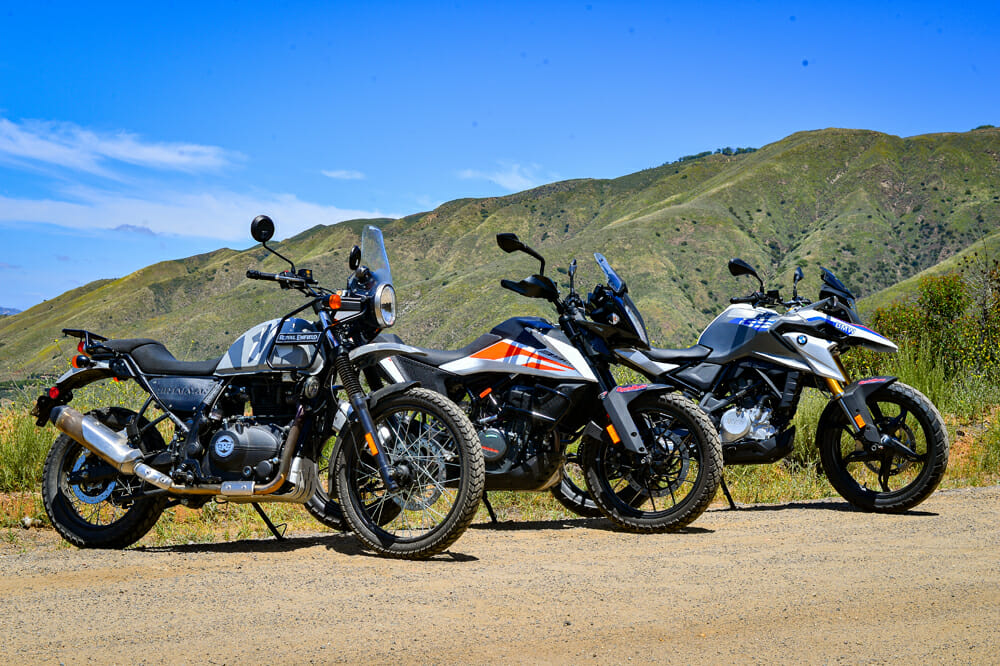
And they are more similar than you think. All are manufactured in India. All come equipped with 70/30 street/dirt tires (or so). All have similar suspension travel and ground clearance. But they all have vastly different approaches to adventure.
If you have $5000-$7000 to get started in motorcycling, this is a great place to start. But which one do you choose!? We’re here to help.

KTM 390 Adventure
The Premium Pick
Our comparison testing leaves no question; the KTM 390 Adventure is the performance and feature-laden winner here. It boasts the most advanced, well… everything.
The KTM 390 Adventure has the most modern look with the most modern ride of the group. It is more than a lookalike of KTM’s aggressive high-performance 790, 1090 and 1290 options. It is high-performance in its own class. Its adjustable WP Apex series suspension is out in front of the competition, and the dynamic five-inch full-color TFT display is higher-spec and more connected than systems coming on bikes costing more than twice as much. The 390 Adventure features Ride by Wire (RBW) throttle and advanced fuel injection. There is little to want from the tech world here, and it’s also the most expensive in this comparison at $6199.
The KTM 390 Adventure leads the field with switchable ABS to an off-road mode (that works great). Also, ABS is lean-angle sensitive when on-street mode, adjusting brake pressure as you corner—truly high-spec. Following that is KTM’s Motorcycle Traction Control (MTC) that limits wheel slip subtly (also lean-angle sensitive). You can turn MTC off for dirt burnouts if you wish (you do).
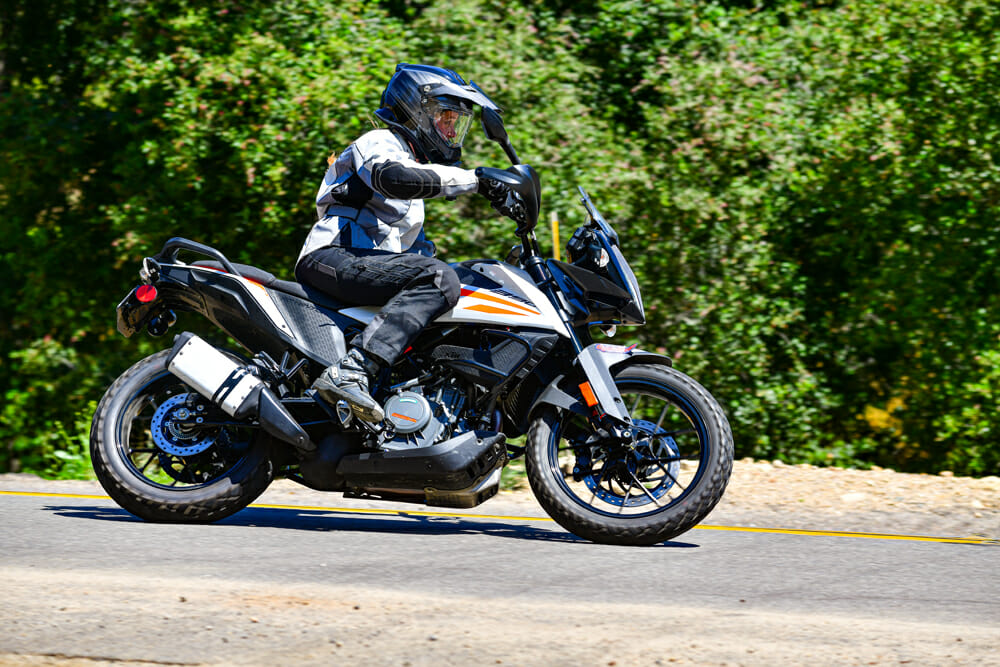
Every one of our test riders put the KTM 390 Adventure on top of the performance deck. It out-accelerates the others and has better overall power character across the board, offering a torquey and fun ride in comparison to others. The BMW and Royal Enfield have good power in areas, but the KTM power is higher performing everywhere. It shines in the mid-to-top with KTM attitude, but roll-on power cranks the little bike out of tight turns finely, too.
Power adjacent componentry is also top-of-the-class with the KTM. The PASC slipper clutch makes aggressive riding smoother with less rear wheel chatter, and shifting is great with the optional dealer-activated Quickshift+, but without it, you’re going to have an easy time jamming through the six-speed tranny. And these bikes get shifted, a lot!
The Bybre brakes by Brembo work superbly on the KTM even though they’re similarly spec’d on the BMW. They are slightly nicer than the Royal Enfield’s units. They feel like a dramatic step up in initial feel and aggressive stopping compared to the two.
When it comes to comfort, the KTM also scored high. Its taller seat height might be a turn off for some, but once seated, its wide and firm platform is the best to tour on thanks to better long-distance comfort. Only the standing ergonomics are cramped on the KTM as the peg-to-bar distance seems to shrink as you stand. But this isn’t as bad as BMW’s ergos.
To sum up the KTM 390 Adventure, you’re simply getting the most for your money, but it takes a little more money to get it. It looks aggressive and high-tech and backs up that look with real functionality across all terrain. From its spunky character to its full LED head and taillights, the KTM 390 Adventure is the leading edge of entry-level ADV and shines brightest in this three-way comparison.
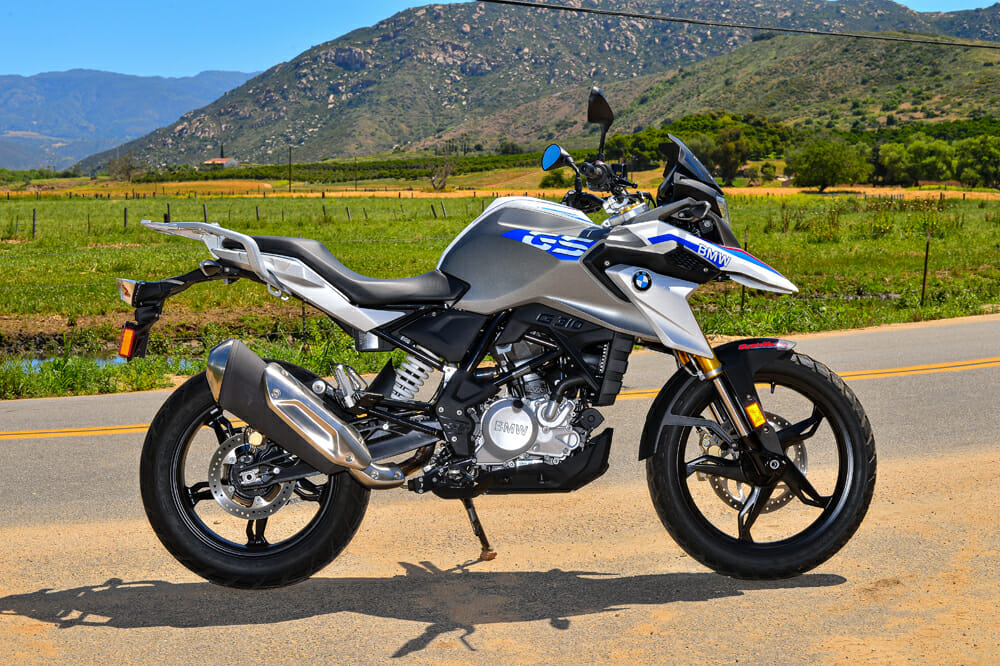
BMW G 310 GS
The Beginner’s Beemer
Just as every one of our test riders placed KTM at the top of the ranks for performance, they placed the 2020 BMW G 310 GS as the best choice for beginners to the adventure-motorcycle lifestyle. It’s mannerism and attitude exude ease-of-use with little to learn from a tech feature standpoint and little to intimidate from the power world. It’s also cheaper than the KTM at $5795.
Even though it’s not the performance leader, the BMW is plenty capable of getting you out exploring new routes and more. There is only one electronic rider aid to adjust, and that is the ABS system, which can be turned off for dirt use. That’s it. Simple.
Power delivery from the BMW G 310 GS comes on silky smooth and consistent if just a little soft. It’s down 60cc to the KTM’s displacement, so it should feel softer, really. Its power pull throughout the rpm range has few weak (or necessarily strong) spots. It just spins with linear delivery that feels very refined and consistent, but not exciting. In a word, you can describe the BMW G 310 GS as simply predictable.
This is what makes it the perfect choice for a first bike, or maybe a first-bike-in-a-while. Like the KTM, the BMW features a nicely spaced six-speed gearbox that shifts cleanly and easily for great long-distance stretches. It features the same nicely performing Bybre brake components (although they don’t work quite as well as KTM’s). This bike rules the tarmac, especially when you’re sitting down, only falling behind KTM in power output and quality of its dash/electronics package while you’re chasing painted lines.
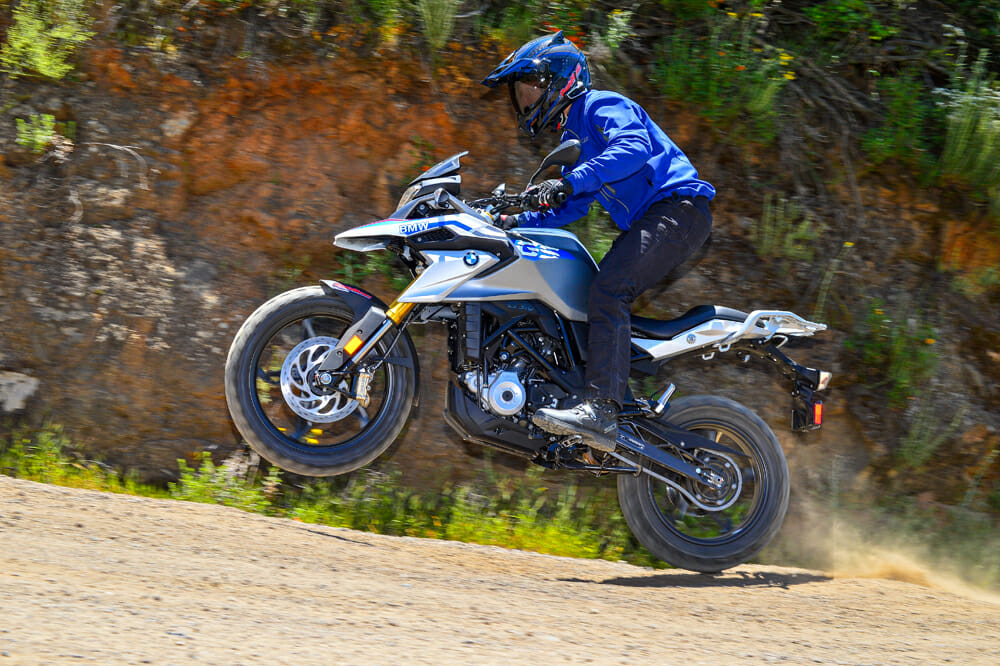
Suspension performance is adequate for road touring duty, and the non-adjustable fork settings seem to hold up to semi-aggressive corner dives just fine. The BMW G 310 GS carves tight pavement roads superbly—the best in this test for that—and the suspension, while limited to shock preload adjustment only, is tuned well for roads. Off-road, the bike starts to show some compromises.
The biggest complaint we registered on the baby BMW is with the tank cover. It makes standing up awkward at best. The worst part is it’s not a tradeoff for capacity. In fact, the BMW’s 2.9-gallon tank is nearly one gallon smaller than KTM’s—and KTM’s is easier to ride with. That fuel reduction means 45-60 miles less range in our MPG tests. So, even though it’s “bigger,” it’s actually smaller. Related, the KTM weighs about five pounds more than the BMW full of fuel. So, KTM is giving you maximum range for almost the same overall weight.
What the big “tank” on the BMW does is lock you into a comfortable sit-down scene. It’s where this bike wants you to be. Also, the excess plastic surrounding the actual tank adds real GS style to this little BMW. It’s a good-looking bike, but it’s coming at the cost of range and stand-up comfort.
BMW comes into this comparison with a model introduced in 2018. So, it’s not the most up-to-date example of BMW tech and is swimming against the current of KTM’s leading tech. Still, at a $400 lower MSRP, it is providing ample on-road performance and plenty of all-around chops for a bike under $6000.
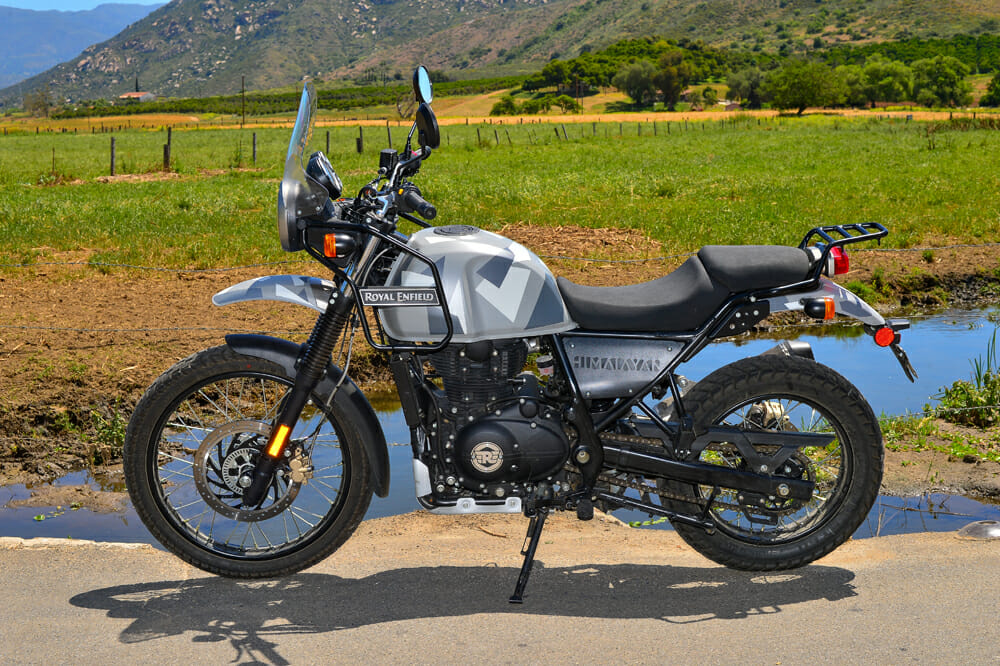
Royal Enfield Himalayan
Royal Charmer
It’d be easy to label the Royal Enfield Himalayan as outgunned in this comparison based on things like tech, specs, performance, modern componentry—everything that bikes try to sell you on. And in most ways, it’s at the bottom of the triangle when stacked up against the more modern (putting it lightly) KTM 390 Adventure and BMW G 310 GS.
But it’s going to charm you into liking it.
The specs don’t lie. The Royal Enfield Himalayan has a claimed 24 horsepower, max, compared to the BMW’s 34 claimed HP, and the BMW feels soft (KTM makes no claims on HP, but it’s likely in the low 40’s). The Himalayan weighs 47 pounds more than the BMW and 42 more than the KTM (all loaded up with fuel).
Let’s not forget the engine is air-cooled.
This lack of luster comes in at $4749. For at least $1000 less than the others, you expect some performance drop off. But riding the bikes back-to-back reveals fewer Royal Enfield deficiencies than you might expect. In fact, this bike has been defended more rigorously by our editorial staff and testing pool than any recent motorcycle. It’s non-threatening.
The Himalayan has the largest engine in the test—almost 100cc bigger than the BWM at 411cc. The long-stroke motor certainly has a sweet spot it likes to run, and our test riders agreed it’s at a comfortable, reasonable 4000-6000 rpm range. This is perfect for cruising pavement or dirt roads, looking at trees, or scouting out a campsite worthy of your Instagram posts. Outside that, it’s either gasping for air trying to get there or starting to vibe out and wishing you’d just give it another gear already. It likes the sweet spot of revs to cruise along at its own pace. It runs like it looks: smooth, industrial, welcoming and fun, but not exciting.
Complicating this power character is a five-speed transmission with big jumps between cogs that seem chunky compared to the others. To ensure adequate speed (we’re talking high 70s, tops), first gear is tall, and the gaps all the way to five are spread out for the pitter-patter of air-cooledness to reach under load.
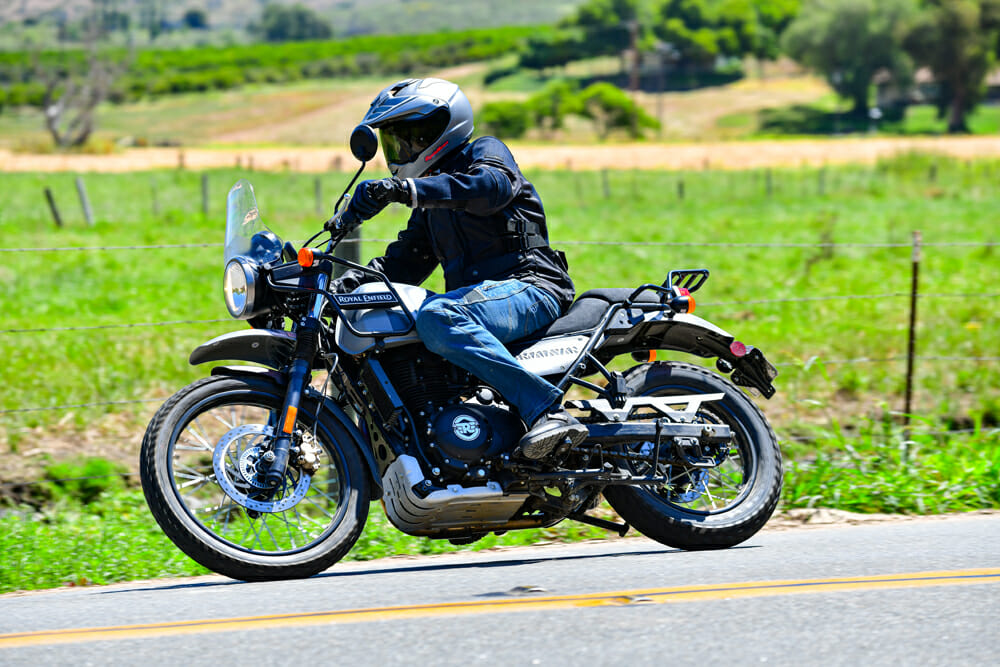
Just as it likes to cruise along in utility, it likes to stop responsibly, calmly and slowly. The Bybre spec brakes on this bike are definitely less powerful. A firm squeeze, and ample early application, are recommended. It does feature front/rear ABS but, unfortunately, it doesn’t turn off. So as robust and analog as it is, it will continue to be digitally frightening on off-road downhills until we figure out how to disable.
The suspension and chassis are built robustly, but not rigid. Inherent flex adds to the smooth ride quality, but you don’t want to push it. And while the fork spec is smaller, the traditional tubes do a fine job of keeping the wheel on the ground—the only 21-inch front in the group. Likewise, the center of gravity feels low, and the seat drops you down into a non-intimidating perch. All add up to a calm, relaxing, old-school ride.
Ergonomics on the Himalayan are really pretty nice, the bars are tall and out front but put you in a sort of comfortable sit-down stance. Standing up is nice, too, with ample room to stretch out and look at the road ahead. The only complaint is seat-to-peg distance being a little cramped. We’d actually prefer a taller seat for all our riding.
Finally, the dash componentry is as low-tech as the rest of the bike, but it does have some digital injection via a cool compass and gear indicator/trip meter functionality.
The Royal Enfield Himalayan is the wanderlust king. It will make you wonder where you can go with it, and how much fun it would be to take a serious step back and enjoy the simple act of moving on two wheels. It’s not going to win much, but it is going to make you smile a lot.
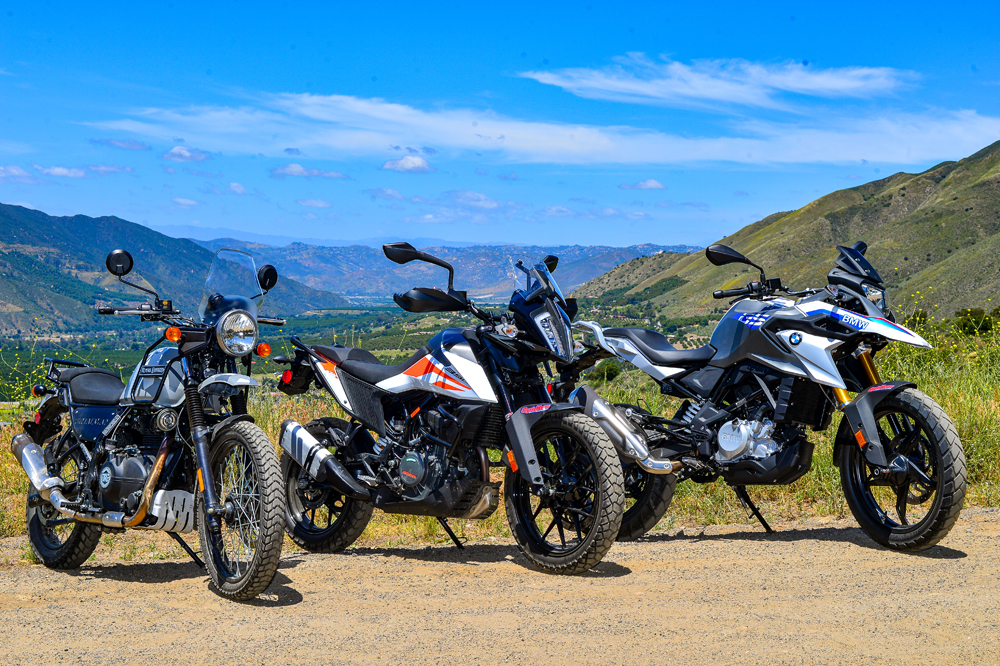
In The Dirt
None of these bikes are a good replacement for a dirt-focused dual-sport. There are smaller displacement options out there that are similarly priced (Honda CRF250L, Suzuki DR-Z400S, Yamaha WR250R, Kawasaki KLX250, to name a few). They will dominate these bikes in the rough stuff. If you want a true travel companion to go longer distances in more comfort, these are hard to beat regardless of the surface.
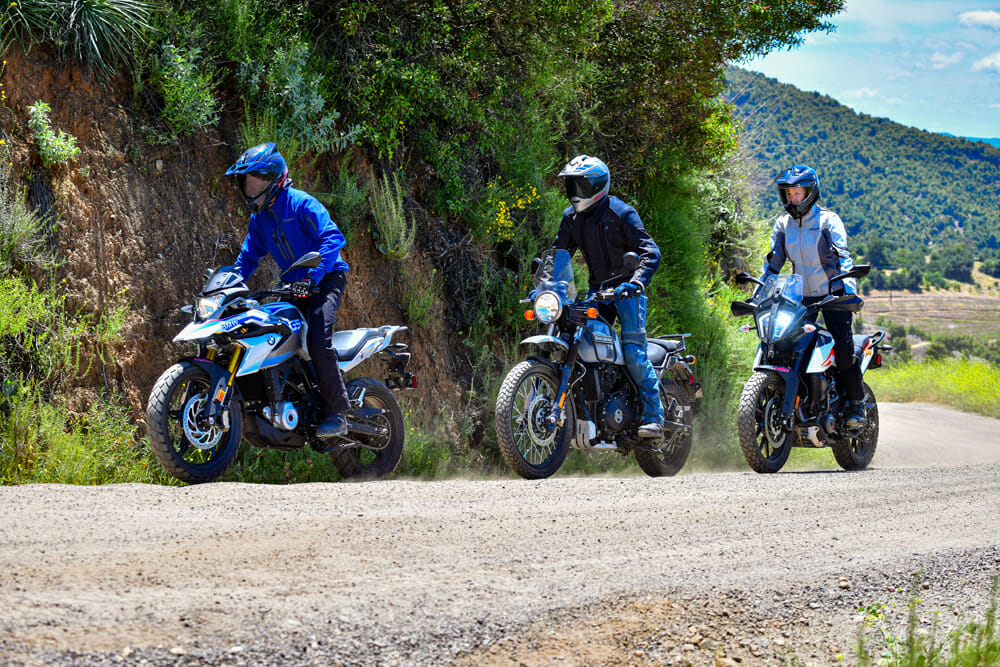
They all have limitations off-road. But the KTM and Royal Enfield shined as the most trustworthy in the rough stuff. KTM takes the overall win here as the only bike with off-road specific ABS and more robust suspension. And while you can turn off the BMW’s, it is almost impossible to ride standing up for very long, and its suspension shows its limits pretty quickly.
The Royal Enfield is the most comfortable in the test to stand on, and it’s 21-inch front wheel rolls over the rough stuff more efficiently. It also has a bit more suspension travel and ground clearance compared to the KTM. As the utility king, we’re pretty sure you could drop the Himalayan off a mountain and start it back up. But its ABS is always on, making it a bit of a liability on the downhills or dirt roads to some extent, it’s considerably heavier, and its brakes aren’t nearly as good. Again, the Himalayan likes to go slower and enjoy the ride. If that’s your style, it will work well for you.
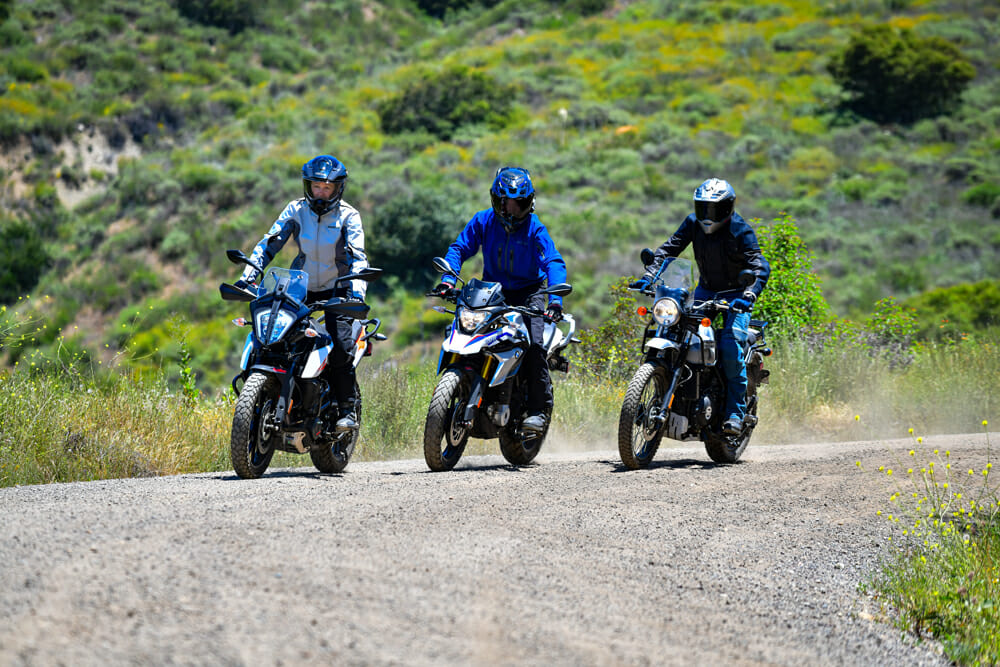
We have little doubt the KTM can take whatever you want to throw at it. And the Royal Enfield will pick its way around just about any terrain at its own pace. So, if you’re serious about hitting a lot of dirt, and don’t really know what the rough road ahead will hold, pick the KTM or the Royal Enfield. CN

Royal Enfield Himalayan Specifications
| MSRP: | $4,749 |
| Engine: | Air-cooled, 4-stroke, SOHC, single |
| Displacement: | 411cc |
| Bore x Stroke: | 78 x 86mm |
| Compression Ratio: | 9.5:1 |
| Power (claimed): | 24 hp at 6500 rpm |
| Torque (claimed): | 25 lb-ft at 4500 rpm |
| Fueling: | EFI |
| Clutch: | Wet, multi-disc |
| Transmission: | 5-speed |
| Chassis: | Half-duplex split cradle steel frame |
| Front Suspension: | 41mm telescopic fork, non-adj. |
| Rear Suspension: | Monoshock, non-adj. |
| Front-Wheel Travel: | 7.9 in. |
| Rear-Wheel Travel: | 7.0 in. |
| Ground Clearance: | 8.7 in. |
| Front Brake: | Bybre single 300mm disc, 2-piston caliper, ABS |
| Rear Brake: | Bybre 240mm disc, 1-piston caliper, ABS |
| Front Tire: | Pirelli MT60 90/90×21 in. |
| Rear Tire: | Pirelli MT60 120/90×17 in. |
| Wheelbase: | 57.6 in. |
| Seat Height: | 31.5 in. |
| Fuel Capacity: | 3.9 gal. |
| MPG (tested results): | 59.1 mpg |
| Weight (full fuel): | 430 lbs. |
| Max Speed: | 79 mph (tested) |
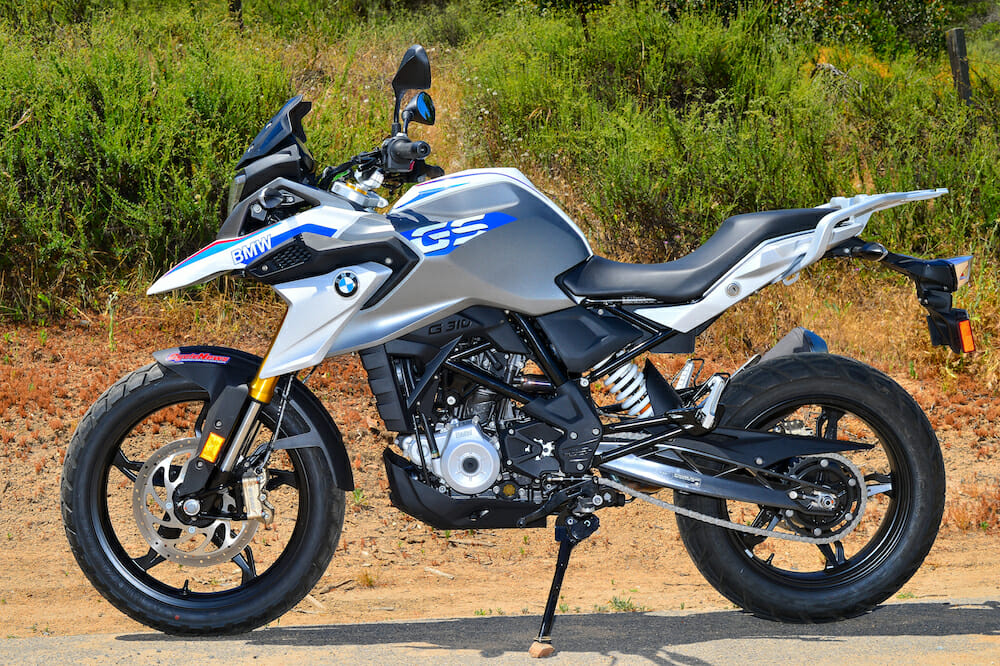
BMW G 310 GS Specifications
| MSRP: | $5,795 |
| Engine: | Liquid-cooled, 4-stroke, DOHC, single |
| Displacement: | 313cc |
| Bore x Stroke: | 80 x 62.1mm |
| Compression Ratio: | 10.6:1 |
| Power (claimed): | 34 hp at 6500 rpm |
| Torque (claimed): | 21 lb-ft at 7500 rpm |
| Fueling: | EFI |
| Clutch: | Wet, multi-disc |
| Transmission: | 6-speed |
| Chassis: | Tubular steel frame in grid structure w/ bolted rear subframe |
| Front Suspension: | 41mm inverted fork, non-adj. |
| Rear Suspension: | Monoshock, w/ preload adj. |
| Front-Wheel Travel: | 7.1 in. |
| Rear-Wheel Travel: | 7.1 in. |
| Ground Clearance: | 8.6 in. |
| Front Brake: | Bybre single 300mm disc, 4-piston caliper, ABS |
| Rear Brake: | Bybre 240mm disc, 1-piston caliper, ABS |
| Front Tire: | Metzeler Tourance 110/80×19 in. |
| Rear Tire: | Metzeler Tourance 150/70×17 in. |
| Wheelbase: | 58.2 in. |
| Seat Height: | 32.9 in. |
| Fuel Capacity: | 2.9 gal. |
| MPG (tested results): | 57.4 mpg |
| Weight (wet, measured): | 383 lbs. |
| Max Speed: | 89 (claimed) |

KTM 390 Adventure Specifications
| MSRP: | $6,100 |
| Engine: | Liquid-cooled, 4-stroke, DOHC, single |
| Displacement: | 373.2cc |
| Bore x Stroke: | 89 x 60mm |
| Compression Ratio: | 12.6:1 |
| Power (claimed): | 42.9 hp |
| Torque (claimed): | N/A |
| Fueling: | EFI |
| Clutch: | Wet, multi-disc, PASC Slipper |
| Transmission: | 6-speed |
| Chassis: | Chromium-Molybdenum-steel trellis frame |
| Front Suspension: | 43mm Apex inverted fork, rebound, compression damping adj. |
| Rear Suspension: | WP monoshock, rebound damping, preload adj. |
| Front-Wheel Travel: | 6.7 in. |
| Rear-Wheel Travel: | 6.9 in. |
| Ground Clearance: | 7.9 in. |
| Front Brake: | Bybre single 320mm disc, 4-piston caliper, ABS |
| Rear Brake: | Bybre 230mm disc, 1-piston floating rear caliper |
| Front Tire: | Continental TKC70 100/90-19 in. |
| Rear Tire: | Continental TKC70 130/80×17 in. |
| Wheelbase: | 56.3 in. |
| Seat Height: | 33.6 in. |
| Fuel Capacity: | 3.8 gal. |
| MPG (tested results): | 55.8 mpg |
| Weight (wet, measured): | 388 lbs. |
| Max Speed: | N/A |
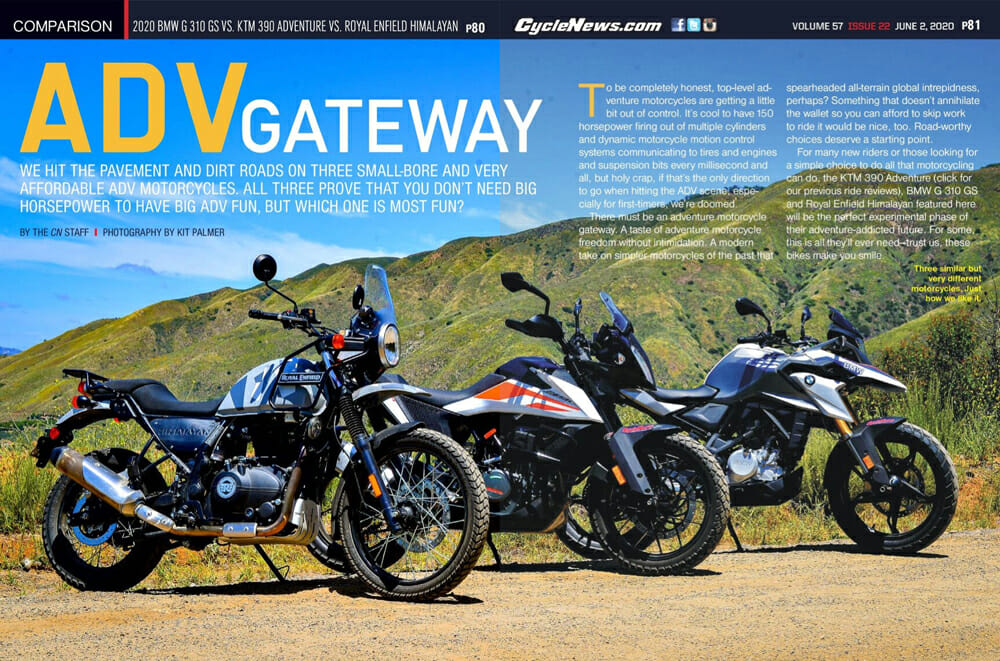
Click here to read Small-Bore Adventure Bike Comparison in the Cycle News Digital Edition Magazine.
Click here for more BMW motorcycle reviews and news.
Click here for more KTM motorcycle reviews and news.
Click here for the latest Cycle News Adventure motorcycle reviews and news.
